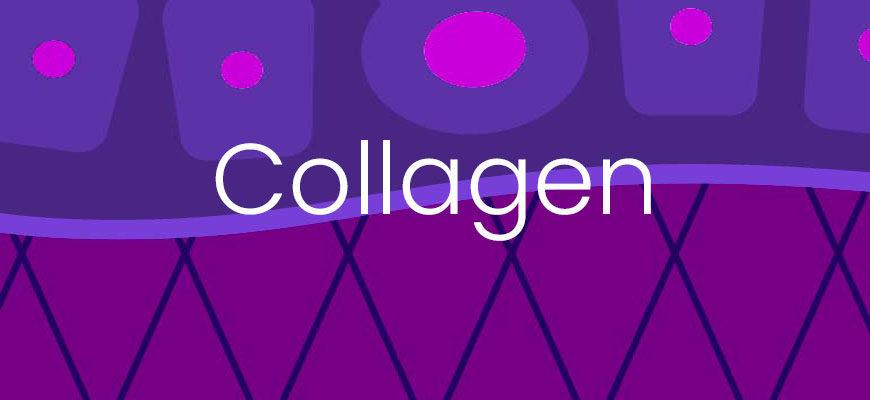Collagen: plastic or scar?
Collagen is the main protein in the connective tissue of the human being and serves to support the scaffolding of the skin, to define the contours of the face and to ensure tone and elasticity.
Two types of collagen are synthesized by the skin: scar tissue and plastic collagen.
Scar collagen is produced when there is a need to repair wounds or insults received and is therefore more rigid and less elastic, often causing more or less obvious scars, while plastic collagen is produced naturally by our skin and gives it support, structure and elasticity.
Fibroblast and its enemies
Collagen in the dermis is produced physiologically by the fibroblast that has the task of synthesizing many substances present in the extracellular matrix.
The production of collagen begins to decline due to endogenous factors (chronological aging, age) and exogenous factors (UV exposure, smoking, unhealthy diet, drug intake). This inefficiency causes the appearance of the first wrinkles, loss of tone and emptying of the tissues.
Collagen is degraded by the phenomenon of protein glycation and by the action of particular enzymes with proteolytic action. Protein glycation, which has been the focus of studies in MyCli’s research laboratories for years, is due to uncontrolled exposure to the sun and to a diet rich in sugars, which, together, favour what in biology we call the “Maillard reaction”, the cause of the stiffening and darkening of the protein fibres themselves.
The action of proteolytic enzymes, called matrix metalloproteinases (MMPs), degrades all the protein chains that form collagen. MMPs increase with increasing age and the balance between endogenous collagen synthesis and its degradation is unbalanced, causing dysfunction of the properties of collagen itself.
The MyCli approach
Poor collagen and its degradation: what are the visible signs on the skin?
The degradation of collagen or a low production by the fibroblast leads to the appearance of tone and expression lines, the emptying of tissues, the loss of compactness and definition of the oval of the face. The skin lacks elasticity and therefore the visible signs of endogenous and exogenous ageing tend to become more marked.
Stimulation and defense of collagen, what are the multitasking actives?
In MyCli, stimulation means re-educating the skin to the endogenous production of plastic collagen, defence, on the other hand, means counteracting the action of glycation and matrix metalloproteinases so that collagen is not compromised.
Several molecules carry out these two actions: the Trilagen KGF peptide complex stimulates the endogenous production of collagen, improves its organization and protects it from enzymatic degradation, carnosine and UVA and UVB filters prevent protein glycation, while the peptides Expretide 8 and Octapeptide 3 promote the relaxation of facial mimic muscles and prevent the formation of expression lines.
Can the fibroblast be educated?
The self-correction mechanism proposed by MyCli aims at re-educating the skin to autonomously produce plastic collagen through the stimulating action of peptides and through the protection of the existing protein fibres. The endogenous correction of these mechanisms is certainly the most performing and less invasive way to recover, from the inside, tonicity, elasticity and support for a “lifted” skin and an oval with firmed and defined contours.
MyCli formulations
We have chosen the best stimulators of endogenous collagen synthesis and its defense.
– Trilagen KGF (Pseudoalteromonas Ferment Extract, Hydrolyzed Soy Protein, Hydrolyzed Wheat Protein, Tripeptide-10 Citrulline, Tripeptide-1) combination of peptides and proteins with triple action on the dermis. In Liftable, they stimulate the production of collagen, improve its organization and protect it from degradation, effectively supporting the lifting-restructuring action.
– Troxerutin (Troxerutin) bioflavonoid that inhibits the oxidation phenomenon of the lipoxygenase and supports capillary resistance, thus preserving vitality and skin tone.
– Expretide 8 (Acetyl Hexapeptide 8) and Octapeptide 3 (Acetyl Octapeptide-3) peptides at myorelaxant action. In Liftable, they are able to mimic the action of botulinum by contrasting the contraction of the muscles and avoiding the formation of expression lines.
– Carnosine (Carnosine) powerful peptide capable of protecting collagen fibers from browning and stiffening (anti-glycation action) and preserve the activity of the metabolic rate of the cells. Its structure makes this peptide one of the most resistant to enzymatic degradation that in Liftable guarantees an effective action of protection of protein fibres.
– Lipoic Acid (Thioctic Acid) antioxidant molecule that acts effectively both in both the intracellular and extracellular environment. In Liftable, it promotes the regeneration of other antioxidant molecules such as vitamins, glutathione and coenzyme Q10 and is in able to counteract the damage caused by various reactive oxygen species.
– Coenzyme Q10 (Ubiquinone) molecule recognized for its effective properties antioxidants and anti photo-aging. In Liftable, it prevents alterations and the disorganization of fibroblasts, preserving their physiological activity against collagen and hyaluronic acid and reduces cellular oxidative damage.




